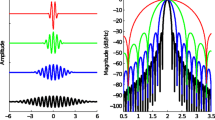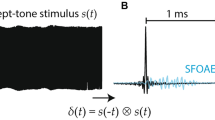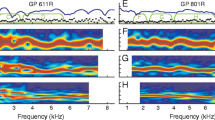Abstract
The presence of short-latency (SL), less compressive-growing components in bandpass-filtered transient-evoked otoacoustic emission (TEOAE) waveforms may implicate contributions from cochlear regions basal to the tonotopic place. Recent empirical work suggests a region of SL generation between ∼1/5 and 1/10-octave basal to the TEOAE frequency’s tonotopic place. However, this estimate may be biased to regions closer to the tonotopic place as the TEOAE extraction technique precluded measurement of components with latencies shorter than ∼5 ms. Using a variant of the non-linear, double-evoked extraction paradigm that permitted extraction of components with latencies as early as 1 ms, the current study empirically estimated the spatial-extent of the cochlear region contributing to 2 kHz SL TEOAE components. TEOAEs were evoked during simultaneous presentation of a suppressor stimulus, in order to suppress contributions to the TEOAE from different places along the cochlear partition. Three or four different-latency components of similar frequency content (∼2 kHz) were identified for most subjects. Component latencies ranged from 1.4 to 9.6 ms; latency was predictive of the component’s growth rate and the suppressor frequency to which the component’s magnitude was most sensitive to change. As component latency decreased, growth became less compressive and suppressor-frequency sensitivity shifted to higher frequencies. The shortest-latency components were most sensitive to suppressors approximately 3/5-octave higher than their nominal frequency of 2 kHz. These results are consistent with a distributed region of generation extending to approximately 3/5-octave basal to the TEOAE frequency’s tonotopic place. The empirical estimates of TEOAE generation are similar to model-based estimates where generation of the different-latency components occurs through linear reflection from impedance discontinuities distributed across the cochlear partition.










Similar content being viewed by others
References
Arthur RM, Pfeiffer RR, Suga N (1971) Properties of two-tone inhibition in primary auditory neurones. J Physiol 212:593–609
Avan P, Elbez M, Bonfils P (1997) Click-evoked otoacoustic emissions and the influence of high-frequency hearing losses in humans. J Acoust Soc Am 101:2771–2777
Brass D, Kemp DT (1993) Suppression of stimulus frequency otoacoustic emissions. J Acoust Soc Am 93:920–939
Carvalho S, Büki B, Bonfils P, Avan P (2003) Effect of click intensity on click-evoked otoacoustic emission waveforms: implications for the origin of emissions. Hear Res 175:215–225
Charaziak KK, Souza P, Siegel JH (2013) Stimulus-frequency otoacoustic emission suppression tuning in humans: comparison to behavioral tuning. J Assoc Res Otolaryngol 14:843–862
Choi YS, Lee SY, Parham K, Neely ST, Kim DO (2008) Stimulus-frequency otoacoustic emission: measurements in humans and simulations with an active cochlear model. J Acoust Soc Am 123:2651–2669
Cooper NP (1996) Two-tone suppression in cochlear mechanics. J Acoust Soc Am 99:3087–3098
Delgutte B (1990) Two-tone rate suppression n auditory-nerve fibers: dependence on suppressor frequency and level. Hear Res 49:225–246
Dhar S, Rogers A, Abdala C (2011) Breaking away: violation of distortion emission phase-frequency invariance at low frequencies. J Acoust Soc Am 129:3115–3122
Geisler CD, Yates GK, Patuzzi RB, Johnston BM (1990) Saturation of outer hair cell receptor currents causes two-tone suppression. Hear Res 44:241–256
Gilman S, Dirks DD (1986) Acoustics of ear canal measurement of eardrum SPL in simulators. J Acoust Soc Am 80:783–793
Goodman SS, Fitzpatrick DF, Ellison JC, Jesteadt W, Keefe DH (2009) High-frequency click-evoked otoacoustic emissions and behavioral thresholds in humans. J Acoust Soc Am 125:1014–1032
Goodman SS, Mertes IB, Scheperle RA (2011) Delays and growth rates of multiple TEOAE components. In: Shera CA, Olson ES (eds) What fire is in mine ears: progress in auditory biomechanics: Proceedings of the 11th International Mechanics of Hearing Workshop, American Institute of Physics, pp 279-285
Hoaglin D, Mosteller F, Tukey JW (1983) Understanding robust and exploratory data analysis. Wiley, New York
Jedrzejczak WW, Blinowska KJ, Konopka W (2005) Time-frequency analysis of transiently evoked otoacoustic emissions of subjects exposed to noise. Hear Res 205:249–255
Kalluri R, Shera CA (2007a) Near equivalence of human click-evoked and stimulus-frequency otoacoustic emissions. J Acoust Soc Am 121:2097–2110
Kalluri R, Shera CA (2007b) Comparing stimulus-frequency otoacoustic emissions measured by compression, suppression, and spectral smoothing. J Acoust Soc Am 122:3562–3575
Keefe DH (1998) Double-evoked otoacoustic emissions. I. Measurement theory and nonlinear coherence. J Acoust Soc Am 103:3489–3498
Keefe DH (2012) Moments of click-evoked otoacoustic emissions in human ears: group delay and spread, instantaneous frequency and bandwidth. J Acoust Soc Am 132:3319–3350
Keefe DH, Ling R (1998) Double-evoked otoacoustic emissions. II. Intermittent noise rejection, calibration and ear-canal measurements. J Acoust Soc Am 103:3499–3508
Keefe DH, Ellison JC, Fitzpatrick DF, Gorga MP (2008) Two-tone suppression of stimulus frequency otoacoustic emissions. J Acoust Soc Am 123:479–1494
Keefe DH, Goodman SS, Ellison JC, Fitzpatrick DF, Gorga MP (2011) Detecting high-frequency hearing loss with click-evoked otoacoustic emissions. J Acoust Soc Am 129:245–261
Kemp DT, Bray P, Alexander L, Brown AM (1986) Acoustic emission cochleography—practical aspects. Scand Audiol Suppl 25:71–95
Kemp DT, Ryan S, Bray P (1990) A guide to the effective use of otoacoustic emissions. Ear Hear 11:93–105
Lewis JD, Goodman SG (2014) The effect of stimulus bandwidth on the nonlinear-derived tone-burst-evoked otoacoustic emission. J Assoc Res Otolaryngol. doi:10.1007/s10162-014-0484-6
Lineton B, Wildgoose CMB (2009) Comparing two proposed measures of cochlear mechanical filter bandwidth based on stimulus frequency otoacoustic emissions. J Acoust Soc Am 125:1558–1566
Lucertini M, Moleti A, Sisto R (2002) On the detection of early cochlear damage by otoacoustic emission analysis. J Acoust Soc Am 111:972–978
Mertes IB, Goodman SS (2013) Short-latency transient-evoked otoacoustic emissions as predictors of hearing status and thresholds. J Acoust Soc Am 134:2127–2135
Moleti A, Botti T, Sisto R (2012) Transient-evoked otoacoustic emission generators in a nonlinear cochlea. J Acoust Soc Am 131:2891–2903
Moleti A, Al-Maamury AM, Bertaccini D, Bott T, Sisto R (2013) Generation place of the long- and short-latency components of transient-evoked otoacoustic emissions in a nonlinear cochlear model. J Acoust Soc Am 133:4098–4108
Moleti A, Sisto R, Lucertini M (2014) Experimental evidence for basal place-fixed generation of short-latency TEOAE components. Assoc Res Otolaryngol Midwinter Meet Abstr PS-122(37):69–70
Murnane OD, Kelly JK (2003) The effects of high-frequency hearing loss on low-frequency components of the click-evoked otoacoustic emission. J Am Acad Audiol 14:525–533
Neely ST, Norton SJ, Gorga MP, Jestaedt W (1988) Latency of auditory brain-stem responses and otoacoustic emissions using tone-burst stimuli. J Acoust Soc Am 83:652–656
Pang XD, Guinan JJ Jr (1997) Growth rate of simultaneous masking in cat auditory-nerve fibers: relationship to the growth of basilar-membrane motion and the origin of two-tone suppression. J Acoust Soc Am 102:3564–3575
Patuzzi R (1996) Cochlear micromechanics and macromechanics. In: Dallos P, Popper AN, Fay RR (eds) The cochlea. Springer, New York, pp 186–257
Rasetshwane DM, Neely ST (2012) Measurements of wide-band cochlear reflectance in humans. J Assoc Res Otolaryngol 13:591–607
Rasetshwane DM, Argenyi M, Neely ST, Kopun JG, Gorga MP (2013) Latency of tone-burst-evoked auditory brain stem responses and otoacoustic emissions: level, frequency, and rise-time effects. J Acoust Soc Am 133:2803–2817
Ren T (2002) Longitudinal pattern of basilar membrane vibration in the sensitive cochlea. J Neurosci 99:17101–17106
Ren T, Nuttall AL (2001) Basilar membrane vibration in the basal turn of the sensitive gerbil cochlea. Hear Res 151:48–60
Rhode WS (2007) Basilar membrane mechanics in the 6-9 kHz region of sensitive chinchilla cochleae. J Acoust Soc Am 121:2792–2804
Robles L, Ruggero MA (2001) Mechanics of the mammalian cochlea. Physiol Rev 81:1305–1352
Ruggero MA, Rich NC, Recio A, Narayan SS, Robles L (1997) Basilar-membrane responses to tones at the base of the chinchilla cochlea. J Acoust Soc Am 101:2151–2163
Sachs RM, Burkhard MD (1972) Insert earphone pressure response in real ears and couplers. J Acoust Soc Am 52:183
Schairer KS, Fitzpatrick D, Keefe DH (2003) Input-output functions for stimulus-frequency otoacoustic emissions in normal-hearing adult ears. J Acoust Soc Am 114:944–966
Schairer KS, Ellison JC, Fitzpatrick D, Keefe DH (2006) Use of stimulus-frequency otoacoustic emission latency and level to investigate cochlear mechanics in human ears. J Acoust Soc Am 120:901–914
Shera CA, Guinan JJ Jr (1999) Evoked otoacoustic emissions arise by two fundamentally different mechanisms: a taxonomy for mammalian OAEs. J Acoust Soc Am 105:782–798
Shera CA, Guinan JJ Jr (2003) Stimulus-frequency-emission group delay: a test of coherent reflection filtering and a window on cochlear tuning. J Acoust Soc Am 113:2762–2772
Shera CA, Tubis A, Talmadge CL, Guinan JJ Jr (2004) The dual effect of “suppressor” tones on stimulus-frequency otoacoustic emissions. Assoc Res Otolaryngol Midwinter Meeting Abstract 538 27:181
Shera CA, Guinan JJ Jr, Oxenham AJ (2010) Otoacoustic estimation of cochlear tuning: validation in the chinchilla. J Assoc Res Otolaryngol 11:343–365
Siegel JH, Cerka AJ, Recio-Spinoso A, Temchin AN, van Dijk P, Ruggero MA (2005) Delays of stimulus-frequency otoacoustic emissions and cochlear vibrations contradict the theory of coherent reflection filtering. J Acoust Soc Am 118:2434–2443
Sisto R, Moleti A (2007) Transient evoked otoacoustic emission latency and cochlear tuning at different stimulus levels. J Acoust Soc Am 122:2183–2190
Sisto R, Moleti A, Lucertini M (2001) Spontaneous otoacoustic emissions and relaxation dynamics of long decay time OAEs in audiometrically normal and impaired subjects. J Acoust Soc Am 109:638–647
Sisto R, Sanjust F, Moleti A (2013) Input/output functions of different-latency components of transient-evoked and stimulus-frequency otoacoustic emissions. J Acoust Soc Am 133:2240–2253
Stinson MR, Lawton BW (1989) Specification of the geometry of the human ear canal for the prediction of sound-pressure level distribution. J Acoust Soc Am 85:2492–2503
Stinson MR, Shaw EAG, Lawton BW (1982) Estimation of acoustical energy reflectance at the eardrum from measurements of pressure distribution in the human ear canal. J Acoust Soc Am 72:766–773
Tavartkiladze GA, Frolenkov GI, Kruglov AV, Artamasov SV (1994) Ipsilateral suppression effects on transient evoked otoacoustic emission. Brit J Audiol 28:93–204
Tognola G, Grandori F, Ravazzani P (1997) Time-frequency distributions of click-evoked otoacoustic emissions. Hear Res 106:112–122
Withnell RH, McKinley S (2005) Delay dependence for the origin of the nonlinear derived transient evoked otoacoustic emission. J Acoust Soc Am 117:281–291
Withnell RH, Yates GK (1998) Enhancement of the transient-evoked otoacoustic emission produced by the addition of a pure tone in the guinea pig. J Acoust Soc Am 104:344–349
Withnell RH, Yates GK, Kirk DL (2000) Changes to low-frequency components of the TEOAE following acoustic trauma to the base of the cochlea. Hear Res 139:1–12
Withnell RH, Hazlewood C, Knowlton A (2008) Reconciling the origin of the transient evoked otoacoustic emission in humans. J Acoust Soc Am 123:212–221
Zettner EM, Folsom RC (2003) Transient emission suppression tuning curve attributes in relation to psychoacoustic threshold. J Acoust Soc Am 113:2031–2041
Zhang X, Heinz MG, Bruce IC, Carney LH (2001) A phenomenological model for the responses of auditory-nerve fibers: I. Nonlinear tuning with compression and suppression. J Acoust Soc Am 109:648–670
Zweig G, Shera CA (1995) The origin of periodicity in the spectrum of evoked otoacoustic emissions. J Acoust Soc Am 98:2018–2047
Acknowledgments
Subject compensation was provided by a grant from the Executive Council for Graduate and Professional Students at the University of Iowa. The authors thank Rachel Stanziola and Brittany James who performed the data collection for this study. Portions of this work were presented at the 2013 Annual Meeting of the American Auditory Society and the 2014 Mid-winter Meeting of the Association for Research in Otolaryngology. This research served as part of the first author’s dissertation work at the University of Iowa.
COI Disclosure Statement
Neither of the authors have a commercial interest or other conflict of interest concerning the research detailed in the submitted manuscript. Funds for data collection (subject compensation) were provided by a grant from the Executive Council for Graduate and Professional Students at the University of Iowa.
Author information
Authors and Affiliations
Corresponding author
Rights and permissions
About this article
Cite this article
Lewis, J.D., Goodman, S.S. Basal Contributions to Short-Latency Transient-Evoked Otoacoustic Emission Components. JARO 16, 29–45 (2015). https://doi.org/10.1007/s10162-014-0493-5
Received:
Accepted:
Published:
Issue Date:
DOI: https://doi.org/10.1007/s10162-014-0493-5




